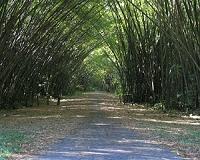| . |  |
. |
Boulder CO (SPX) Jan 26, 2010 Contrary to conventional belief, as the climate warms and growing seasons lengthen subalpine forests are likely to soak up less carbon dioxide, according to a new University of Colorado at Boulder study. As a result, more of the greenhouse gas will be left to concentrate in the atmosphere. "Our findings contradict studies of other ecosystems that conclude longer growing seasons actually increase plant carbon uptake," said Jia Hu, who conducted the research as a graduate student in CU-Boulder's ecology and evolutionary biology department in conjunction with the university's Cooperative Institute for Research in Environmental Sciences, or CIRES. The study will be published in the February edition of the journal Global Change Biology. Working with ecology and evolutionary biology professor and CIRES Fellow Russell Monson, Hu found that while smaller spring snowpack tended to advance the onset of spring and extend the growing season, it also reduced the amount of water available to forests later in the summer and fall. The water-stressed trees were then less effective in converting CO2 into biomass. Summer rains were unable to make up the difference, Hu said. "Snow is much more effective than rain in delivering water to these forests," said Monson. "If a warmer climate brings more rain, this won't offset the carbon uptake potential being lost due to declining snowpacks." Drier trees also are more susceptible to beetle infestations and wildfires, Monson said. The researchers found that even as late in the season as September and October, 60 percent of the water in stems and needles collected from subalpine trees along Colorado's Front Range could be traced back to spring snowmelt. They were able to distinguish between spring snow and summer rain in plant matter by analyzing slight variations in hydrogen and oxygen atoms in the water molecules. The results suggest subalpine trees like lodgepole pine, subalpine fir and Englemann spruce depend largely on snowmelt, not just at the beginning of the summer, but throughout the growing season, according to the researchers. "As snowmelt in these high-elevation forests is predicted to decline, the rate of carbon uptake will likely follow suit," said Hu. Subalpine forests currently make up an estimated 70 percent of the western United States' carbon sink, or storage area. Their geographic range includes much of the Rocky Mountains, Sierra Nevada and high-elevation areas of the Pacific Northwest. Study co-authors included David Moore of King's College London and Sean Burns of the National Center for Atmospheric Research and CU-Boulder.
Related Links Cooperative Institute for Research in Environmental Sciences Forestry News - Global and Local News, Science and Application
 SRNL Assesses Bamboo Crop
SRNL Assesses Bamboo CropSavannah River SC (SPX) Jan 26, 2010 Many people who grow bamboo in their yards soon regret it, and spend the rest of their days trying to kill it off. The U.S. Department of Energy's Savannah River National Laboratory (SRNL), however, is glad to have a bamboo nursery. These are the kinds of bamboo that can be troublesome to property owners-the kinds with runners-but that feature is exactly what makes them possibly valuable t ... read more |
|
| The content herein, unless otherwise known to be public domain, are Copyright 1995-2009 - SpaceDaily. AFP and UPI Wire Stories are copyright Agence France-Presse and United Press International. ESA Portal Reports are copyright European Space Agency. All NASA sourced material is public domain. Additional copyrights may apply in whole or part to other bona fide parties. Advertising does not imply endorsement,agreement or approval of any opinions, statements or information provided by SpaceDaily on any Web page published or hosted by SpaceDaily. Privacy Statement |